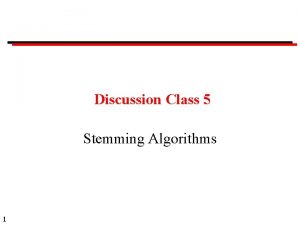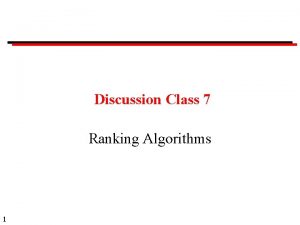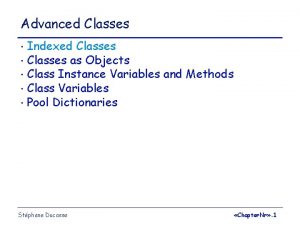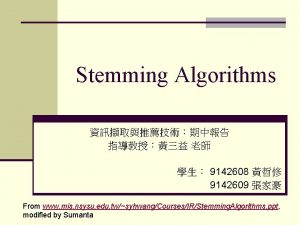Discussion Class 3 Stemming Algorithms 1 Discussion Classes










- Slides: 10

Discussion Class 3 Stemming Algorithms 1

Discussion Classes Format: Question Ask a member of the class to answer Provide opportunity for others to comment When answering: Give your name. Make sure that the TA hears it. Stand up Speak clearly so that all the class can hear 2

Question 1: Conflation methods (a) Define the terms: stem, suffix, prefix, conflation, morpheme (b) Define the terms in the following diagram: Conflation methods Manual Automatic (stemmers) Affix removal Longest match 3 Successor variety Simple removal Table lookup n-gram

Question 2: CATALOG System Search Term: users Term 1. user 2. users 3. used 4. using Occurrences 15 1 3 2 Which term (0 = none, CR = all): (a) The CATALOG stemmer differs in a fundamental way from other tools that we have seen in this course. What is it? (b) What impact does this have on measurements of precision and recall? 4

Question 3: Successor variety methods Test word: FINDABLE Corpus: ABLE, APE, DABBLE, FIND, FINDABLE, FINDER, FOUND, FINISH, FIXABLE Prefix F FI FINDAB FINDABLE 5 (a) Fill in this table Successor Variety Letters

Question 3 (continued): Successor variety methods (a) Segment FINDABLE using the complete word segmentation method. (b) Segment FINDABLE using the peak and plateau method. 6

Question 4: n-gram methods (a) Explain the following notation: statistics => st ta at ti is st ti ic cs unique diagrams =>at cs ic is st ta ti statistical => st ta at ti is st ti ic ca al unique diagrams => al at ca ic is st ta ti (b) Calculate the similarity using Dice's coefficient: S = 2 C A+B A is the number of unique diagrams in the first term B is the number of unique diagrams in the second term C is the number of shared unique diagrams (c) Explain the statement that it is a bit confusing to call this a "stemming method". 7

Question 5: Porter's algorithm (a) What is an iterative, longest match stemmer? (b) How is longest match achieved in the Porter algorithm? 8

Question 6: Porter's algorithm Conditions Suffix Replacement Examples (m > 0) eed ee feed -> feed agreed -> agree (*v*) ed null plastered -> plaster bled -> bled (*v*) ing null motoring -> motor sing -> sing (a) Explain this table (b) How does this table apply to: "exceeding", "ringed"? 9

Question 7: Evaluation (a) In Web search engines, the tendency is not to use stemming. Why? (There at least three answers. ) (b) Does your answer to part (a) mean that stemming is no longer useful? 10
 Stemming algorithms
Stemming algorithms Benefits stemming from space exploration
Benefits stemming from space exploration Já classe e subclasse
Já classe e subclasse Pre ap classes vs regular classes
Pre ap classes vs regular classes Simple distillation conclusion
Simple distillation conclusion Class discussion rules
Class discussion rules Today there is class
Today there is class Package mypackage; class first { /* class body */ }
Package mypackage; class first { /* class body */ } Abstract class vs concrete class
Abstract class vs concrete class Lower class boundary of the modal class
Lower class boundary of the modal class Class i vs class ii mhc
Class i vs class ii mhc


















